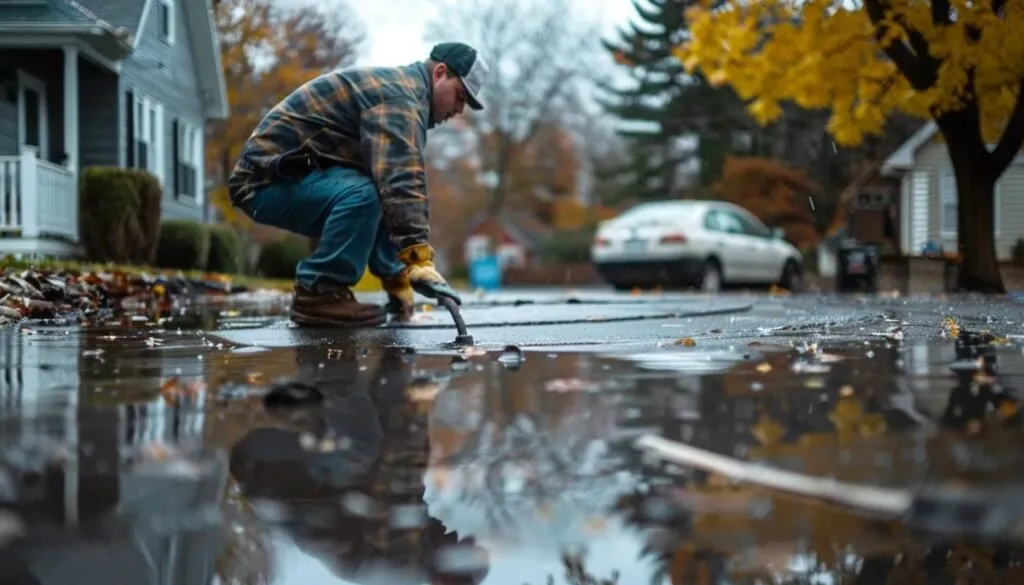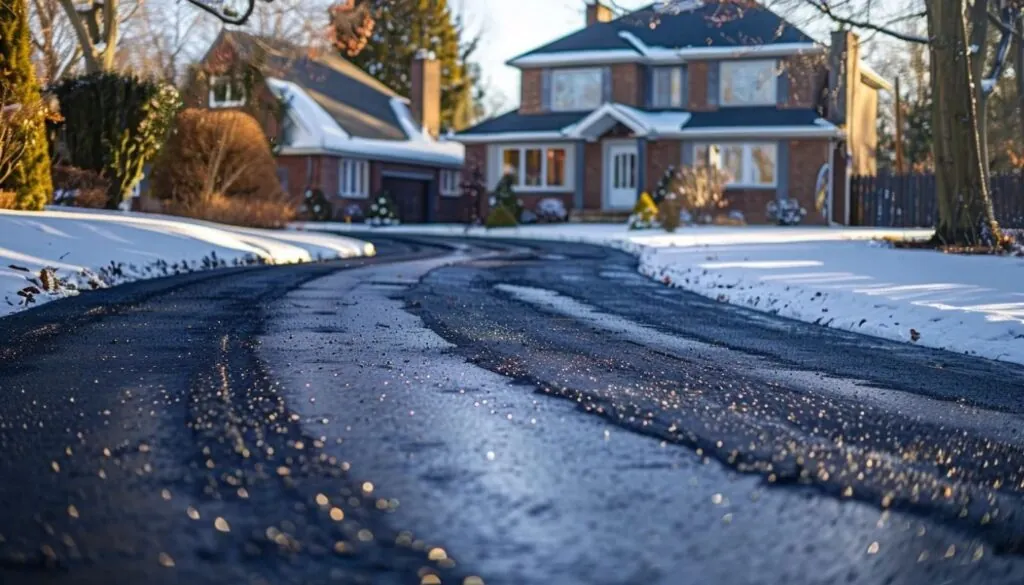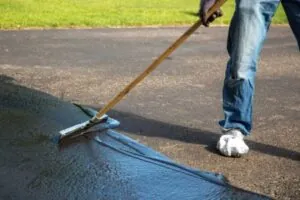As winter approaches, many homeowners wonder, “When is it too late to seal a driveway?” Understanding the timing for driveway sealcoating is essential for protecting it against snow, ice, and salt damage that can degrade its surface. Asphalt driveways benefit greatly from a fresh layer of sealant, which prevents cracks and guards against long-term damage. Ideally, sealcoating should be completed when temperatures are above 50°F (10°C) during the day and remain so overnight. This allows the sealant to adhere properly and cure fully, enhancing its durability.
Waiting too long can expose your driveway to winter’s harsh elements, leading to cracks, water penetration, and erosion, resulting in costly repairs. Properly sealing your driveway enhances its appearance and extends its lifespan, ensuring it stays protected and looks its best through the colder months. With this overview in place, let’s take a deeper dive into seal coating and how best to apply it before the winter chill sets in!
Why Sealcoating Your Driveway Matters Before Winter
Sealcoating the driveway before winter is essential for maintaining its condition. Homeowners should ask themselves: when is it too late to seal a driveway? Early action is critical to preventing driveway damage.
Prevents Water Penetration
Sealcoating is a protective barrier against water intrusion, which is crucial in winter. Ice can widen existing cracks, leading to more significant driveway damage. Applying sealant before the first frost helps maintain structural integrity and prevents potholes from forming due to freeze-thaw cycles. Homeowners with paver driveways also benefit, as proper sealcoating preserves appearance and durability, reducing the need for costly repairs in the future.
Guards Against Oxidation
Sealcoating provides essential protection against oxidation, particularly for asphalt driveways. Exposure to UV rays causes asphalt to break down, leading to flexibility loss and surface cracks. These cracks can worsen rapidly in freezing temperatures, resulting in severe damage. Preparing your driveway with sealcoating helps combat both UV exposure and humidity fluctuations, ultimately prolonging its lifespan. After thorough cleaning, this proactive approach can prevent the cycle of ice damage and deterioration.
Enhances Appearance
Beyond protection, sealcoating significantly enhances your driveway’s visual appeal. A quality sealant restores faded asphalt to its rich, dark color, making it look new. This improvement boosts property value and reflects diligent maintenance. A smooth finish can also conceal minor imperfections, contributing to an inviting look. Regular maintenance, including timely repairs and sealcoating, helps prevent cracks and blemishes, ensuring your driveway remains attractive and resilient against the elements.
When Is It Too Late to Seal a Driveway?
Determining when it’s too late to seal a driveway before winter is crucial for homeowners. Planning ahead and considering climate is essential to ensure timely application and safeguard against potential driveway damage.

Ideal Temperature
Homeowners often wonder about the ideal temperature for sealcoating a driveway. For optimal results, temperatures should be above 50 degrees Fahrenheit, allowing the sealant to dry and bind effectively. With milder days, late autumn represents the last suitable opportunity for this task before winter sets in. If temperatures drop too low during application, the sealant may fail to adhere correctly, leaving the driveway vulnerable to harsh winter conditions.
Avoid Freezing Conditions
Timing is critical when planning to sealcoat driveway, mainly to avoid freezing conditions. If temperatures are forecasted to drop near freezing, the sealant may not cure effectively, compromising its protective capabilities. A consistent, frost-free period after application is necessary for the sealant to form a durable barrier against winter elements. To sealcoat driveway in cold climate reduces effectiveness and can also waste time and resources, leading to potential driveway cracks and damage.
Can You Seal a Driveway After the First Frost?

Sealing a driveway after the first frost is generally not advisable due to the significant challenges of cold temperatures. When frost sets in, the drop in temperature can prevent the sealant from adequately bonding with the asphalt, diminishing its effectiveness. This lack of adhesion can leave your driveway vulnerable to winter conditions, increasing the risk of driveway cracks and potential damage over time.
Experts typically recommend completing asphalt driveway sealcoating well before the first frost to ensure optimal results and maximum durability. By sealing your driveway early, you enhance its resistance to harsh weather and protect your investment from costly repairs that may arise later. Understanding when to seal the driveway is essential for long-term maintenance and preservation. Prioritizing this task in the fall can save you time and money, ensuring your driveway remains in good condition throughout winter.
Similar Post:Can You Seal Your Driveway this Fall?
How Does Cold Weather Affect Sealcoating?
Cold weather presents significant challenges for sealcoating driveways. Homeowners should be aware of the risks to maintain the integrity of their asphalt driveways and protect against potential winter damage.
Slower Cure Times
Colder temperatures extend the cure time of the sealant when sealing a driveway. Insufficient warmth can leave the product tacky and vulnerable to damage, potentially necessitating reapplication. The bond between the sealant and the driveway material is crucial for creating a protective layer. To ensure effective asphalt driveway sealcoating, homeowners should aim to sealcoat when temperatures are favorable, allowing the sealant to set and safeguard against winter conditions.
Increased Cracking Risk
Cold weather increases the likelihood of cracking during the sealcoating process. Low temperatures can cause materials to contract, preventing the sealant from bonding properly and creating gaps. These gaps can lead to cracks that widen with freeze-thaw cycles, further exposing the driveway to damage. To mitigate this risk, homeowners should prioritize sealcoating under appropriate conditions, ensuring a robust and durable surface that can withstand winter’s effects.
Sealant May Not Adhere
Cold conditions can hinder sealants’ adhesive properties, resulting in weak bonds when applied at low temperatures. If the sealant fails to adhere properly, it won’t protect against winter elements adequately. A strong bond is essential for preventing moisture infiltration and preserving driveway integrity. Homeowners should take advantage of suitable weather to apply sealcoating, ensuring optimal adhesion and long-lasting protection throughout the winter months.
Related Post:When is the Best Time to Seal Your Driveway?
Seal Your Driveway Before It’s Too Late!
Timing is critical for driveway maintenance, particularly when it comes to sealcoating. So, when is it too late to seal a driveway? Sealing your driveway before winter arrives is essential, as applying sealant in cold weather is ineffective. Proper sealing protects against driveway damage from ice and water infiltration. Schedule your sealcoat application during warm weather to ensure optimal adhesion and create a durable barrier against the impending freeze.
Neglecting to seal your driveway at the right time can lead to costly repairs. Early intervention is key; addressing driveway cracks and other issues before temperatures drop helps preserve your asphalt driveway. By sealing your driveway proactively, you enhance its longevity and appearance, ensuring it withstands harsh winter conditions.
Protecting your driveway is an important investment. Asphalt driveway sealcoating is vital to preventive maintenance, providing a shield against winter’s challenges. Not only does it guard against deterioration, but it also boosts your property’s curb appeal, making it a worthwhile endeavor.
Understanding When to Seal Your Driveway: Conclusion and Key Takeaways
Sealcoating your driveway before winter is essential to prevent water damage and cracking caused by freeze-thaw cycles. Timeliness is critical; cold weather can hinder the sealant’s ability to cure and adhere properly, leaving your asphalt driveway unprotected. Experts recommend sealcoating when temperatures exceed 50 degrees Fahrenheit to ensure practical application and long-lasting results. If you wait too long, you may miss the ideal window for sealing, leading to driveway cracks and significant damage that results in costly repairs. Understanding when to seal your driveway is vital for maintaining its integrity and prolonging its lifespan. Preemptive care will ultimately save you time and money in the long run.
Frequently Ask Questions
1. Should I seal my driveway before winter?
Yes, sealing your driveway before winter is highly recommended. Winter weather, especially freezing temperatures, snow, and ice, can damage an unsealed driveway by allowing water to penetrate and freeze in cracks, expanding them and causing erosion. Sealcoating before winter protects the driveway’s surface and helps prevent costly repairs.
2. What temperature is too cold for driveway sealing?
Driveway sealcoating should ideally be done in temperatures above 50°F (10°C) during the day, and it’s best if the temperature stays above this overnight as well. If temperatures fall below this range, the sealant may not adhere properly or cure effectively, leaving the driveway exposed to winter weather risks.
3. What time of year should you seal your driveway?
The best time to seal a driveway is during the warmer months, typically late spring through early fall, when temperatures are consistently above 50°F. Late autumn can still be suitable in some regions, but it’s essential to check weather forecasts and avoid sealing too close to freezing temperatures to ensure proper curing and adhesion.
4. Is it worth sealing an old driveway?
Yes, sealing an older driveway can be beneficial if the surface is structurally sound. A fresh layer of sealant can enhance its appearance, protect it from further wear, and prevent damage from winter weather, extending its lifespan. However, if the driveway has extensive cracks or structural issues, it may require repairs or resurfacing before sealcoating.
5. Why is sealing your blacktop driveway pointless?
Sealing a blacktop driveway is generally not pointless; in fact, it protects the driveway against UV rays, water infiltration, and seasonal freeze-thaw cycles. However, sealcoating may be ineffective if applied in poor weather conditions or if the driveway has severe underlying damage. For the best results, ensure proper application timing and repair any significant issues before sealing.
6. Should you seal your driveway in spring or fall?
Both spring and early fall are good times to seal a driveway, provided the temperatures are warm enough. Spring sealcoating can repair winter damage and prepare the driveway for summer heat, while fall sealing helps protect it against winter’s harsh conditions. Choose a time when temperatures are consistently above 50°F to ensure a durable and effective seal.



